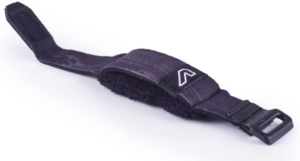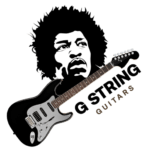This Post May Contain Affiliate Links
In compliance with the FTC guidelines, please assume that some of the links on these posts and sites are affiliate links (Amazon or others) from which I may earn a small compensation/commission from sales of certain items at no extra cost to you from qualifying purchases.
Anytime you see a link that looks like “astore.com, paid link, #ad, #CommissionsEarned or Amazon/Amazon.com/ca,”… it can be assumed that it is an affiliate link.
To learn more, follow the link below.
GruvGear
This article will focus on the “Fretwraps” created by Gruv Gear, also called dampeners or guitar muters. They are very accessible, inexpensive, and varied in styles.
GurvGrear Fretwraps maintains one of the best standards in the market niche for this product, from extra padding for pressure and string control to easy strap adjustment and movement around the neck. (See image)
What Is A Fretwrap?
This innovative guitar dampening accessory is designed to sit in front of the nut or move on your fretboard to mute and kill string overtones from your playing and aid in controlling the mechanical noise created from “Sympathetic Vibration,” and help to keep your guitar quiet. (See image below)
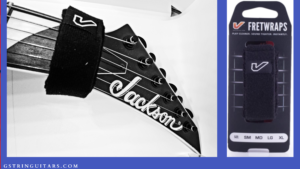
An image of the Fretwrap by Gruv-Gear collared around the headstock of a guitar.- Image of fret wrap courtesy of Amazon.ca
Sympathetic Vibration
This phenomenon is when a vibration responds to an external vibration with a harmonic likeness, so if one part of your guitar vibrates, another part vibrates as well, and this can produce overtones.
What Are Fretwrap Used For?
Fretwraps dampen or mute strings and remove a lot of the natural overtones from your playing that you get from your strings and make you sound sloppy, especially at louder levels, giving you a cleaner note articulation and improving the mechanical noise commonly generated from the guitar itself. ( More on this later)
How Does A Fretwrap Work?
The small accessory easily wraps around the guitar neck like a collar, generally around the headstock or first fret. It is simply adjustable with a velcro strap and fastened through a plastic loop like a watch strap that loosens or tightens quickly as needed; the adjustable strap lets you fine-tune the pressure and dampening of the strings.
(See the below image)
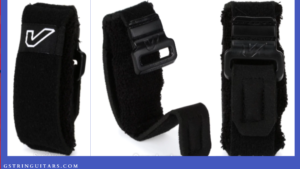
GruvGear Fretwraps with adjustable velcro straps, made from polyester material and extra padding, available in Small-M-L-XL- Image courtesy of Sweetwater-Tap Image for purchase.
The Fretwraps cover each string evenly, and you can adjust the tightness, making them more effective than the homemade attempts at this tool.
ie
- Hairbands/Scrunchie
- Tape /Velcro
- Nylons
This string dampener provides far more padding than typical homemade products commonly used, comes in multiple sizes and styles to fit your guitar’s neck correctly, and is visually more attractive.
This guitar accessory needs no particular tool, special installation, or custom guitar modifications.
Being that this is not a standard tool in a guitarist’s arsenal, how can such a small and inexpensive accessory give you such a significant result and is it something you could get value out of and should invest in?
Suppressing String Noises
Using a string dampener can clean up your playing even if you already use perfect muting techniques to suppress string noise while playing, but traditional muting has its limits.
Traditional Muting & String Noise
Traditionally some muting or dampening could be done with a right-hand picking “Plam mute” technique but only in some areas of your playing.
Palm-muting generally is when you place the edge of your right hand near or on the bridge, creating a dampening/muting effect on the strings, a technique that was masterly done by such virtuosos as Al Di Meola.
But even with right-hand techniques like palm muting, the potential for unwanted noise is still present. This is almost all guitarists and guitars, so while proper muting technique can remove some of this vibration, it cannot eliminate it all.
Do Fretwraps Make A Difference
Great For Techniques Like Sweeping Or Two-Handed Tapping
When it comes to some of the more popular guitar skills like the “Two-Handed Tapping or Sweeping Techniques,” the positioning of your right hand is no longer able to mute or dampen while playing, potentially creating unwanted string noise or ringing.
So for areas of your playing, look to dampeners, which are an excellent tool for this style of playing. (See the below image)

Guitar Icon Eddie Van Halen doing his “Two-Handed Tapping Technique” Image courtesy of Wikimedia- Author-Carl Lender-And is licensed under the Creative Commons Attribution 2.0 Generic
Getting Creative
And in some cases, based on your right-hand technique alone, the ability to palm mute is not possible, so finding creative ways to prevent those unwanted sounds is warranted.
Check out Marty Friedman and his approach to dampening the unwanted string noises while in the studio, based on his unorthodox right-hand technique.
Versatile & Moveable
Typically the fret wrap is used when playing in the higher regions of the fretboard; the string dampeners quiet any noise of open strings and prevent excess or unwanted string tones, allowing you to engage in complex passages on the guitar with clean articulation.
Musicians have found that sliding the tool as needed in either direction has advantages. When not required, it can be easily removed or quickly slid over the headstock, where it can be accessed whenever the need arises or aid in string overtones above the nut.
Position it just past the nut inside the first fret, and you can still play open strings with minimal muting, but slide it up the neck and dampening becomes increasingly more noticeable. It’s effortless to reposition on the fly while playing for the ultimate in control.
The Fretwrap is versatile and easily moveable.
Controlling Unwanted Mechanical Noise
Every guitar has some mechanical /sympathetic vibration or overtone noise
Based on the flaw in how guitars are designed and constructed, they are instruments designed to be sound-sensitive.
- String vibrate nonintentional
- Mechanical noise is happening
Mechanical noise comes from the Headstock, Bridge & Back Tremolo Springs on an electric guitar.
With mechanical noise, as with most things on the guitar, the louder the volume, the more you notice it.
This accessory will only deal with the headstock’s mechanical noise and double as a dampener.
Where Would A FretWrap Be Used?
Studio
The Fretwrap is great for studio, during recording sessions
There is nothing worse than getting a guitar lead piece locked down, and after listening to the recording, the guitar parts are perfect, but the string noise or overtones can not be edited out; those little sounds get easily picked up, leaving you to redo takes.
A tiny amount of string noise can ruin an otherwise perfect take; it can be costly and frustrating.
When it comes to recording, you will want to do everything possible to get your playing and sound perfect.
Fretwraps will help prevent a portion of sonic overtones during studio recording sessions or anywhere you need to pay attention to those micro precision elements of your sound, keeping your strings quiet, allowing the session player to focus on your best take and playing right the first time, saving time and money, not to mention your reputation.
This holds true for recording software that is not professional studio quality as well.
Live Playing
If Fretwraps work well in the studio, can they also work for live playing?
Live performances will be noisy no matter how hard you try, and keeping unwanted string noise or overtones at bay is a challenge every performer must deal with.
The sound tech will handle the group’s output, but your guitar playing and gear are your challenges.
Fretwraps can benefit you on both these issues.
They can help minimize mechanical noise or control unwanted feedback when the accessory is on the headstock and mute open string noise if you use it higher on the fretboard.
Playing guitar parts can trigger accidental open string noise or parts that a conventional right-hand technique is impossible to mute.
Your confidence will grow when you know that during a solo, having several strings ringing will not be an issue when performing and showcasing your flawless technical abilities.
This also goes for a live recording where you want to keep unwanted string noise at bay.
Practice
While you are woodshedding, Fretwraps will help you perfect your playing along with giving you the confidence to work on challenging guitar techniques like…
- Sweeps
- Arpeggios
- Alternate picking &
- Two-handed tapping
Fretwraps will dampen any unwanted string noise and take the stress of muting those unwanted strings off the plate, especially if you do not have a skilled right hand.
Once you get one hand perfected, you can remove the string dampener and look to apply the right-hand muting component to the overall technique with confidence.
Do Fretwraps Make A Difference?
A Guitar Tool & Nothing More
When it comes to skill as a guitarist, nothing will replace the time and tested ‘Woodshedding” that needs to happen to get your skills established.
This accessory will NOT make you any better than you were, but it will aid as a tool to help you develop, and for such a small investment, it would be worth a try. The one thing to remember is that it is a tool, and like any tool, it has its place and purpose.
For the beginner, it will help you sound better by the tool minimizing unwanted string noise.
For the professional player, it will give you that extra level of finesse and clean tone.
It will depend on you; some guitarists will use them, and some will not, but that does not make you any less of a player.
Some may use them in the studio when recording to focus only on their playing and not worry about having to redo the passage because of unwanted tones.
Some may use them live because they play at a high level and deals with string vibration.
Some may use them just for practice and work on developing advanced techniques.
If noise is a problem, then a string dampener is an accessory for you.
What Is The Difference Between A Capo & Fretwrap?
A capo is an accessory used to shorten the strings’ length or raise the guitar’s pitch, resulting in the ability to play in a different key signature but still allowing for the same fingerings as if you would be playing open, usually without the capo attached.
In essence, the capo is the moveable guitar nut, a common tool for acoustic guitar players.

An Image of a Trigger-style capo and how it works- Image courtesy of Wikimedia- Author Connormah and is licensed under the Creative Commons Attribution-Share Alike 3.0 Unported
Like the Fretwrap, the capo comes in several sizes or shapes designed for different instruments and fretboards. The capo clamps to the neck of the instrument in some fashion in the design to hold down the strings, not dampening or muting like the Fretwrap.
The Fretwrap cannot create the same pressure needed to hold down strings uniformly so that all of the strings have uniform position and pressure, but the Fretwrap will give you different results that are just as valuable.
When It Comes To Guitar String Dampeners
One size does not fit all guitars.
The Fretwraps come in Small, Medium, Large, and Xtra Large.
They tell you what size generally fits with what type of guitar or bass, based on the size of the neck of your instrument and may vary depending on the manufacturer.
But generally, the larger sizes are better suited to larger necks like classical guitars and basses.
Looking online to see the product’s specs is helpful, but the best thing to do is try it for your instrument to see what will work and is a good fit. (See the below image)
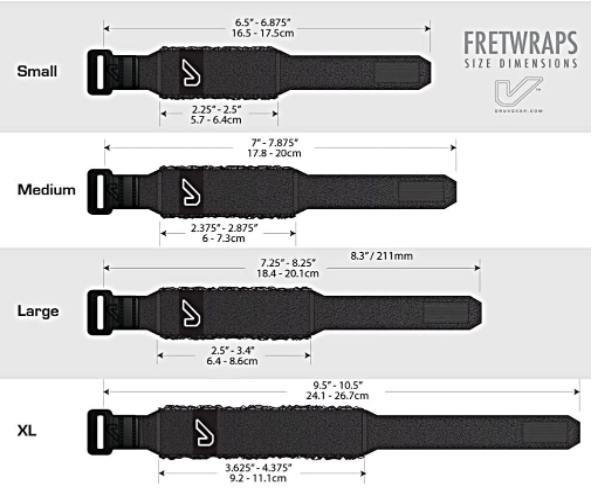
The Gruv Gear Fretwraps Size Chart- Image courtesy of gruvgear.com.
Pricing
Their pricing for this concept ranges but is generally very affordable.
Compared to other accessories, Fretwraps offer some of the best value for the price.
Gruv Gear put out an excellent product that’s very affordable and does so much. I can think of only a few other accessories that can be used in various situations.
Check Out How Two-Handed Tapping & A Fretwrap Work & Sound
Do Fretwraps Make A Difference?
FretWraps from GruvGear
$12.99
Starting A Journey At 7 Years Of Age, The Love For The Guitar Only Became Stronger Going Into My Teens. This Leading To An Exciting Time Of Teaching, Performing, And Recording. Join Me Now As We Can Bring The Love Of This Instrument To Other Musicians Globally.


